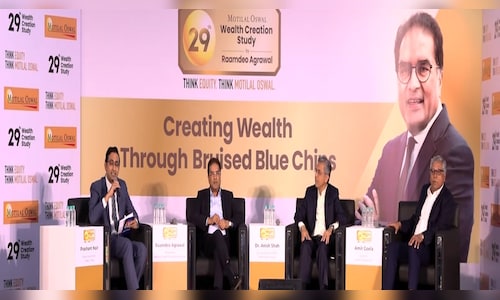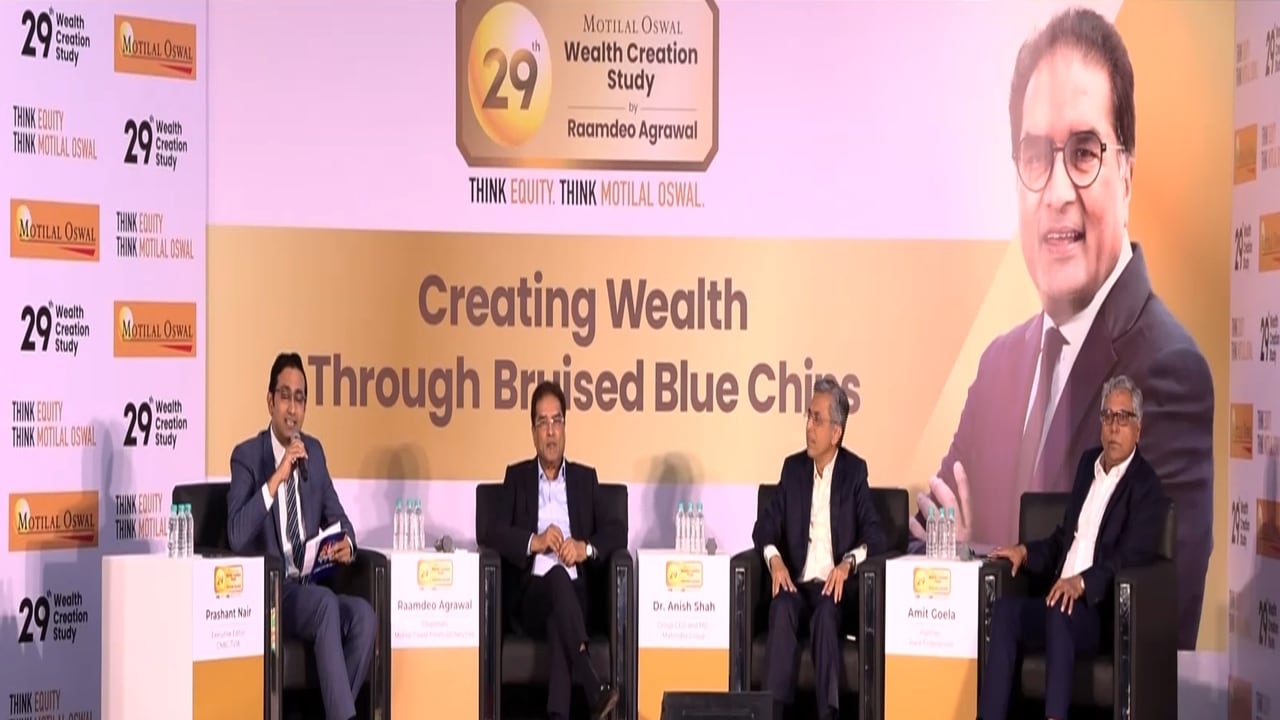

To delve deeper into the findings, CNBC-TV18 interviewed Raamdeo Agrawal, Chairman & Co-Founder of Motilal Oswal Financial Services; Amit Goela, Partner at Rare Enterprises; Anish Shah, MD & CEO of Mahindra Group; and Akhil Gupta, Vice Chairman of Bharti Enterprises.
Below are the excerpts of the discussion.
Q: How to profit from blue chips which have fallen out of favour, bruised blue chips as Raamdeo Agrawal put it in his study. So what do you mean by bruised blue chips? How do you decide that they are really bruised and how does repair happen and when do you buy them?
Agrawal: So I think there are two aspects. One, is the definition of blue chip itself and then how do we define the bruised blue chips. So blue chips are the companies which in our view earns at least 20% average return on equity for 10 years, and that does the magic of creating wealth for the companies. So 10 years of average return of equity there not many, maybe 22% of the listed companies and top 250 are blue chips. And then also by size. You need to have size and stability, leadership. Blue chips are practiced all over, everybody talks about blue chips but nobody tells the definition of blue chips. So we have defined for the study definition of blue chips.
Second is what is a bruised blue chip? Bruised blue chips are companies in last five years, whatever is the high and now the companies have fallen by more than 50%. Say if company has gone to say ₹1,000 and it has fallen below ₹500 – 60-80% – so those companies are bruised, but they have not lost the blue chip status, but for some reason competition or failed products or regulator or whatever, the stocks have fallen by more than 50% that we call them bruised. So these are the two things which we have to keep in mind while talking about bruised blue chips.
Q: Typically, one would imagine that blue chips don’t get bruised, right? Once in a while they do. COVID happens or the global financial crisis happens. But otherwise, blue chips are blue chips. But as your study shows, they do and quite regularly?
Agrawal: Quite regularly, in fact every year. If you see the study period of five years, every time out of 250 companies, 78 companies are the blue chips on an average and of that 40 or literally half they get bruised. Other half they don’t get bruised. So no blue chief has travelled the journey without getting bruised. Maybe TCS or Infosys might be two or three companies, but actually almost all the companies they go through a rough patch and that is the point of time when they’re deeply bruised and if you understand the company, you can buy tons of them.
Q: As your study shows, the hit rate is pretty good. When you buy them at that very, very bruised state, you tend to make a lot of money.
Agrawal: I have not practiced. Because for me this is just a study. But if you practice it, I mean few companies I know for sure which came to my mind, one was, Jindal Steel, DLF at ₹70-80, I have gone on record saying that this a great time to sell your real estate portfolio and buy into DLF. So 2-3 companies I remember, but I have not made too much of money out of bruised blue chips.
Q: Raamdeo Agrawal said he’s not practicing, but Amit has been a big practitioner over the last two decades plus. So tell us a little bit?
Goela: Rakesh Jhunjhunwala was the practitioner of this kind of investing. I was supporting him, I was helping him doing the work. But the real practitioner was Rakesh Jhunjhunwala. And I’ve seen him consistently over a period of time pick stocks like this which were in trouble or the companies were in trouble and he’s made serious money in them. He never coined them as a bruised blue chip or anything of that kind. He was a value investor and his starting point was that there cannot be a loss of capital. He would invest through leverage and he would service the debt through either dividends or from trading income. So there was no question of a capital loss. Book value I don’t even remember calculating too many times when I was around him. But PE was quite critical and dividend sometimes. Most of these companies were not even giving a dividend because they were in bad shape. So the PE was very critical. The market cap in terms of the opportunity, that was very critical. Those were the couple of things he would look at. And his basic core was there cannot be a capital loss. So he said my edge is I have time on my side, I’ll keep sitting tight. I don’t have any benchmark to beat. I don’t have to prove anything and so I will remain invested but I cannot have a capital loss. That was his basic core of investing in these kind of companies.
He had a very open mind, so it was not like I will only look at one sector. He invested across sectors. We were sector agnostic.
Q: When you came into Mahindra and Mahindra, M&M was not bruised but was going through a tough patch and you came in and you turned things around. Talk to us about that point when you came in, what was in your mind? What was the task given to you and generally what were the conditions? I mean what was the experience like?
Shah: The start of the first phase of my role, the first year was as Deputy MD and Group CFO, began on 2nd April 2020 and that was a time when we had just hit a low point. The stock had lost about 70% of value. Ssangyong was a major burden and we had to close to ₹5,000 crore of losses from what I called our loss making entities. And as a result, the earnings of that year were just about break even and it was the start of COVID and no revenue for the first month of April. So that was the starting point. But the foundation was very strong and that’s one thing I want to highlight in terms of the bruised blue chip story, is that the foundation had been built over many years. And in fact it was a Motilal Oswal analyst report that in 2018 had highlighted that M&M was the best performing stock in the Nifty since 2002. And that doesn’t happen easily. So there were many elements of the company of the group that were important and took us forward and helped us weather the storms.
Yes, there was some reasons for the storms, but the people we had, the talent was of a completely different quality. The ethos of the company, the purpose driven approach, the focus on entrepreneurship, all of those were elements of the DNA of the company and which is why even through those storms, we never really were very concerned because we knew that we were going to get out of that very easily. So I give a lot of credit to our predecessors who really helped set us up for success and we had to just go forward and implement a few things that that we felt were important.
Q: We want to know what did you do? You set the ball rolling, you set RoE targets and you sort of decided to sell off some of these unrelated diversifications and all of those things. I mean, just talk us through those moments and what you saw?
Shah: So let’s start with the losses. We knew that we had to address that and we had to do that quickly. And therefore we created a list of companies that made that ₹5,332 crore of losses. Ssangyong was highest on the list with ₹2,400 crores of losses that year. And we said that if we have to be credible, that’s the first decision we have to take. And a lot of people at that point said – you have said this, but it is not going to happen. And therefore we had to make that happen. But that wasn’t enough because we still had another ₹2,800 crores of losses and therefore we had to exit a number of other companies and we categorised them. We said some of them actually could be good jewels for us if we can turn them around. So our categorisation was – Category A – companies that can be turned around and they will be companies that we will be proud of and they can meet our 18% RoE target. Category B – companies that will likely make some losses but have a quantifiable strategic benefit for US. And Category C is none of the above and therefore we need to exit and we exited 15 companies in the next 18 months or so. And we just moved very quickly and did that. We did not wait in terms of any sequential order. We just started that simultaneously. So that was a first big step.
The second big step was pivot to growth because just meeting an 18% RoE target is not enough. If you don’t see EPS growth as investors, it doesn’t matter from an investor standpoint. So we very quickly pivoted to growth from there and we identified a set of companies that we thought were very strong and what we call the growth gems. And these were strong because they had a strong position in their industry, at least from a potential standpoint. They had a strong what we call right to win. And these growth gems collectively had valuation of less than a billion dollars in March 2020, close to about $900 million. And the first thing we did there was to say that if you have an aspiration to be a billion-dollar company standalone, you will be called a growth gem. And the aspiration has to be matched with a plan that in the next three to five years you will be a billion-dollar company.
Three years later, the collective group had gone from $900 million to $3.4 billion and we raised the bar. At that point we said that to stay a growth gem, you have got to now grow 5x in the next five to seven years, so that $3.4 billion must go to $17 billion. And that’s one part of what’s driving our growth now is the ambition as well as the ability to then deliver on each of our businesses.
Q: Tell us the story about Bharti. It is a sector where regulation is one aspect, competition is another and of course you went through a very large player coming in, disrupting the market in a very, very big way. Tell us the story of Bharti?
Gupta: Telecom industry in India has not only been bruised, it has been battered. It has had existential crisis not once but twice. So it’s been a great journey. And some of the things which we learned in this journey was to stick to some fundamental beliefs. And those beliefs were, one, that in difficult times, strong companies become stronger and weak companies get weaker. Second, that to remain strong, the one major thing you have to take care is your balance sheet. Therefore, whatever you do, keep the balance sheet strong. And third, you’ve got to keep your flock, your people really motivated. Of course, strong balance sheet helps in doing that because the biggest demotivation for people is when you’re not able to pay salaries on time, you are not able to pay vendors on time. I think steadfastly through very difficult periods, we stuck to these three mantras. And so I think we were able to sustain and get over those very tough periods.
Q: The second crisis as you called it when Jio made its entry and it was in the process of garnering subscribers and it very quickly reached a very significant large number. You, kind of stayed the course with these three mantras, as you put it. You knew that you would come out stronger on the other side or was there a moment of doubt?
Gupta: We had no doubt because we had no choice. Unlike many other groups, we only had telecom. We had nothing to say we can shut it down. So we had to stay the course and we really believed in this mantra that if you can get over this difficult period, you will emerge stronger and which we really did. Vodafone-Idea fell into difficult time because I think somehow it just could not manage the balance sheet.
Watch accompanying video for entire discussion.



